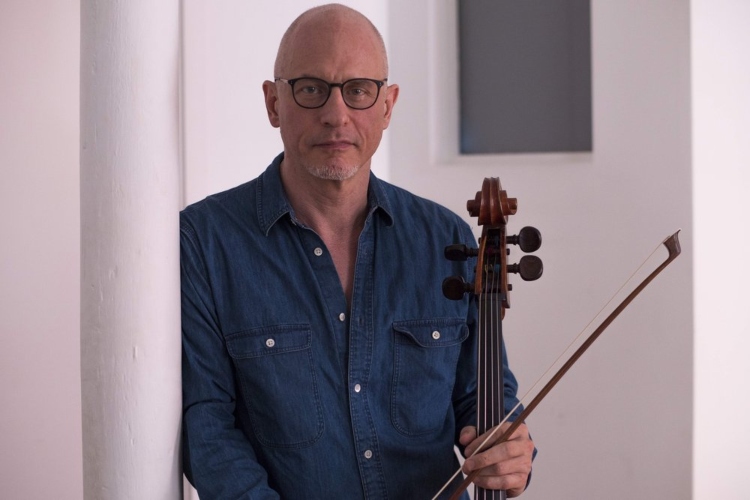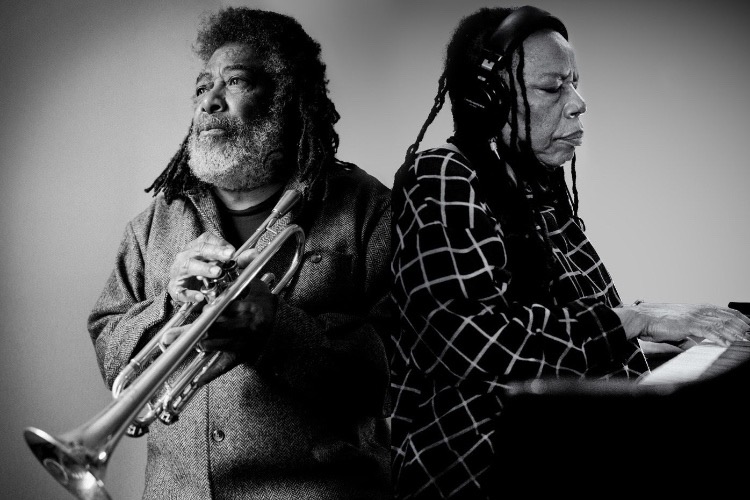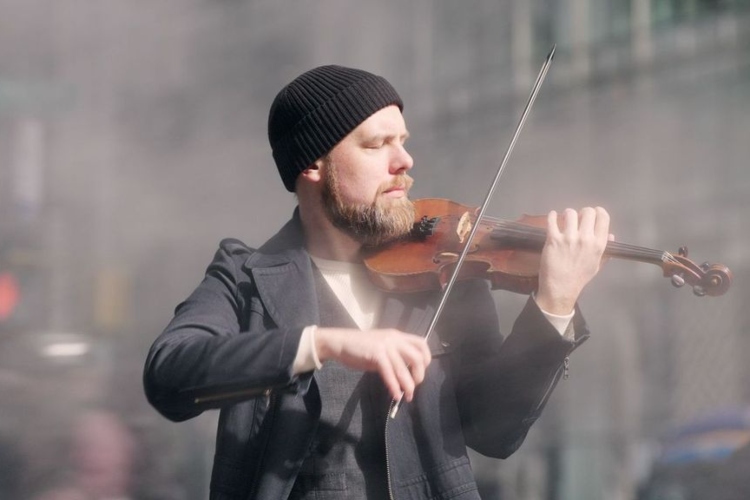Music at the Heart: A Conversation with Erik Friedlander
|
Getting your Trinity Audio player ready...
|
During the seventeenth and eighteenth centuries, the cello established itself as a mainstay in Western European classical music due to its capacity to provide both an intimacy to small chamber ensembles and grandeur to large symphony orchestras. The instrument’s appeal in this space is undeniable; few can listen to Bach’s Cello Suites, specifically the prelude, without being moved. But the cello has always provided access to a palette wider than its classical lineage suggests. Solo, it can access the whole sonic range from bass to soprano. As such, it should come as no surprise that improvisation-based music has its own history of cellists, from Oscar Pettiford to Tomeka Reid. And, even today’s arguably most critically lauded classical cellist, Yo-Yo Ma, has stretched beyond Beethoven or Brahms to encompass Appalachian folk, bluegrass, and Brazilian music. With She Sees (Skipstone, 2023), Erik Friedlander showcases the cello’s power as a rival of the electric guitar in the rock realm.
In full disclosure, Friedlander is hardly the first to explore heavier sounds of the “little violone.” This is not even the first album by his Sentinel, a self-proclaimed “garage band of the 2020s” with guitarist Ava Mendoza, percussionist Diego Espinos, and newcomer bassist Stomu Takeishi. But She Sees is often heavier sounding and more incendiary than its artistic predecessors. Further, where groups like the Electric Light Orchestra, Apocalyptica, or 2Cellos, have all considered the adaptability of the instrument to rock bands, what seems to set Friedlander’s Sentinel apart is its unapologetic adoration of the cello’s natural tones. Rather than attempt to disguise its strings as some bastardized electric guitar or a tool of alien origin, Friedlander largely lets the instrument be itself regardless of the environment which surrounds it. Manipulations of its tone are used sparingly and delicately. The result is tracks like “Baskets, Biscuits, Rain” where the folksier elements of the cello meet a driving blues-rock. Across the album, Mendoza adds a raw grittiness that contrasts particularly well with Friedlander’s often purer impulses, perhaps best seen with the interspersal of surprising elegance between funky rhythms and raw thrashing punkishness on “Tremor, Blink.”
She Sees is continually a work of contrasts and surprises. It is difficult to predict where it will go next. Sometimes, that even includes artful use of space between phrases, perhaps best evidenced in the sparseness of “Heatwave. Friedlander, a virtuoso of New York City’s experimental Downtown scene, is well acquainted with such stylistic shifts. His recorded history includes contemporary classical music, jazz, rock, Americana, and klezmer, with hues of each emerging throughout She Sees. We sat down with Friedlander to discuss the album’s origins, his compositional approach, and the cello’s role in improvised music.
PostGenre: This is your second album with the group Sentinel. How did the band first come together?
Erik Friedlander: Well, I was looking for a different group to write for, and I had worked with Ava Mendoza before. I just felt like an electric guitar was the voice I wanted to feature. I also wanted to use some of the rock influences that I had since my high school days. The electric guitar has always been an instrument I loved.
PG: You actually started on the guitar, right?
EF: I did, yeah.
PG: Do you feel that starting on the guitar, though only a child at the time, at all changed how you write guitar parts compared to if you did not have that experience?
EF: I don’t think it makes much of a difference. I do have a feel for the electric guitar, but I don’t think having my experience with the instrument changes how I write.
PG: One of the things that sets She Sees apart from its predecessor, Sentinel (Skipstone, 2020), is the added presence of a bassist. What was behind the decision to add bass to the group?
EF: I had a [mental] flash one morning that we needed to open the group up a little bit, and I thought [bassist] Stomu [Takeishi] would be the ideal person. I’ve been looking for a project to put Stomu back on, and I felt this was the way to go because adding him to the band’s rhythm section frees up the rest of the players to be more creative, more explosive, and more dynamic.
PG: One admirable thing about both Sentinel records is that while the group is functionally a rock band, your cello tone seems largely unaltered. You easily could have made generous use of pedals or electronic manipulation to produce a heavier sound. Was it a conscious decision not to do so?
EF: Well, I do apply a little distortion, but it’s not so evident. The second record is much more juiced than the first, which almost sounds like a chamber group by comparison. She Sees is more filled out, dynamic, and explosive. [The band’s members don’t] have to serve so many roles, where you can be just a guitarist or a cellist. I don’t have to play bass parts, and Ava can do her thing. It’s much more fun, though the music is hard.
PG: You mean you composed pieces that are difficult to perform?
EF: Yeah.
PG: Do you feel you have learned much from working with John Zorn when it comes to composing? He’s certainly a prolific composer of difficult pieces and you have worked with him frequently.
EF: Sure. I can’t point to something specific, but I am sure I picked up something. He just does it all. He is a model artist, and it’s very inspiring.
PG: Is there a specific project you have done with him of which you are particularly proud?
EF: Almost everything I’ve done with him has been fun and exciting. The solo record [Volac: Book of Angels Volume 8 (Tzadik, 2007)] was a great moment for me. It was really fun to play those pieces. Also, the Masada String Trio works were always a blast to play. Once we figured [the music] out, it was magic. Though we had to play a lot to figure it out.
PG: Do you feel you approach performance differently based on whether the project is a rock-oriented group like Sentinel, one of the Masada String Trio projects, or the more Americana-influenced works of Bonebridge?
EF: No, I don’t. I just immerse myself in the music and then do what it demands. I first serve the needs of the music.
PG: Do you think the fact that you are a cellist has held you back at all, solely because it is a less conventional improvisational instrument?
EF: It probably did back when I was starting out since there was not as much demand for the cello as other instruments. But it also may have helped me because there were fewer people for a particular project that did call for the cello. In any event, though, I had to deliver when the time came, just like anyone else. In that sense, I wasn’t so different from anybody playing any instrument. Of course, now there are many more cellists, but back when I started, there were only a few – Hank Roberts and Abdul Wadud, and a few others. Now there is this whole generation of cellists.
PG: Why do you think there has been a proliferation of improvising cellists?
EF: I think it’s just the natural evolution of the instrument. It had to happen. The classical side of the instrument has been explored so vastly and thoroughly that it had to peter out. So many really fine cellists started to apply themselves to jazz and improvisation, and it just blossomed. Now there are so many great players Mike Block and Stephan Braun and…
PG: Tomeka Reid
EF: Absolutely, yeah, Tomeka.
PG: That is another interesting aspect to the increased number of improvising cellists. You and the people you mentioned are cellists first. Earlier on, musicians, usually bassists, improvising on cello were primarily using it as a second instrument. Oscar Pettiford, Ray Brown, Dave Holland, and Ron Carter were all bassists first. Do you feel fewer bassists are doubling on cello today solely because there are now so many high-quality bassists making improvised music?
EF: It could be. But we still need bass players who want to get a cello and set it up. Oscar Pettiford was a little bit of an exception to the names you mentioned because he was such an incredible composer. He surrounded himself with great musicians and put his cello at the center. I excuse his paternalistic attitude on the cello because he was such a fine composer, and so much great music was made by him on the cello.
PG: She Sees is your fourth album as a leader since you were diagnosed with Parkinson’s Disease in 2016. Obviously, your tremors from Parkinson’s may impact your ability to perform, but do you feel the illness has impacted you as a composer in terms of how you approach or think about music?
EF: Composing is one of the only things that hasn’t been impacted. I feel that my compositional ideas come from another source and just happen. Everything else has been impacted. My playing has been impacted. My life has been impacted. But composing has not been impacted.
PG: And related to Parkinson’s, one thing that sets She Sees apart from your other three albums since your diagnosis is that it was the first after you underwent Deep Brain Stimulation (DBS) surgery. [ed.: DBS is a neurosurgical procedure where electrodes are implanted within certain areas of the brain.] Were you ever concerned before the procedure that it might impact the creative portions of your brain?
EF: The doctors never mentioned anything like that happening. I guess if I had thought about it I would have been worried about it. But I wasn’t concerned. It’s not a very new procedure. It’s kind of an older technology that has been used for many years and is becoming more de rigueur for Parkinson’s patients who, like me, had tremors as their main symptom. The surgery eliminates tremors. I’m performing the best I have in years, and it is getting better and better.
PG: And you can certainly hear not only the strength in your playing but also see your creativity in both the compositions and the concept behind She Sees. Would you mind explaining the album’s title?
EF: Sure. It’s just an idea that I had of a sentinel watching over the world. It’s kind of naive sounding, but it’s a strong image for me, and I found a piece of artwork for the album that works great with that idea. It’s kind of a sentinel who’s watching without judgment. Without actively doing anything, just watching and observing the good and the bad.

PG: Do you typically write the music and then later find the artwork you think will fit it, or do you sometimes find artwork and then write music around it?
EF: The music always comes first since the the music is heart of the project. I find the music first, then I sequence the tunes and finish the names on the tunes. Most of the time, I just number the pieces and then play these numbered but untitled pieces with the band to get a better sense of what they’re about, and sometimes that spawns a title. Sometimes it even spawns a name for the entire album. But it’s always the music at the heart of the project. Then I will find artwork that works for it.
PG: So, is your music ever inspired by artwork, or is it always more of an after-the-fact consideration?
EF: No, I’m inspired by artwork all the time. I go see a lot of artwork, and it inspires my music.
PG: Since we are on visual art, do you feel your father provided an entry into the creative music scene at a younger age than you otherwise may have had? [Ed.: Erik’s father, Lee Friedlander, is an acclaimed photographer whose work has been featured on many iconic albums, including Miles Davis’ In a Silent Way (Columbia, 1969), John Coltrane’s Giant Steps (Atlantic, 1960) and My Favorite Things (Atlantic, 1961), Ray Charles’ What’d I Say (Atlantic, 1959), and Ornette Coleman’s Change of the Century (Atlantic, 1960).]
EF: You would think that would have happened but not really. I learned a lot about eclectic listening from my father, but he has a somewhat narrow sense of music. I think that’s just a function of age. He thinks of rhythm and blues and jazz from the 1950s and 60s as the pinnacle of music. He’s not really into anything outside of that. Of course, when he was younger, it was that music he loves that was then considered cutting-edge.
PG: Is there a particular work of his that especially resonates with you? There were some incredible pictures of your mother and you as a kid in the New Yorker.
EF: Yeah. Well, for us, growing up with him, he was just like the annoying guy who would stop you in the middle of whatever you were doing and take a picture. Or, while were on a cross-country trip, he would pull the car over to the side of the road, in 105-degree heat in Phoenix, to take a picture of a bush or something. It wasn’t such a grandiose experience, I guess. I love his work, and there are certainly some of my favorites. In a way, he’s like Zorn; a talented person who worked hard and made a successful creator out of being an artist. That’s not an easy thing to do, and inspiring in that way. The work ethic and amount of time he still, even today at almost age 90, puts into his work is very inspiring.
She Sees will be released on May 26, 2023, on Skipstone Records. More information on Friedlander can be found on his website.




2 thoughts on “Music at the Heart: A Conversation with Erik Friedlander”